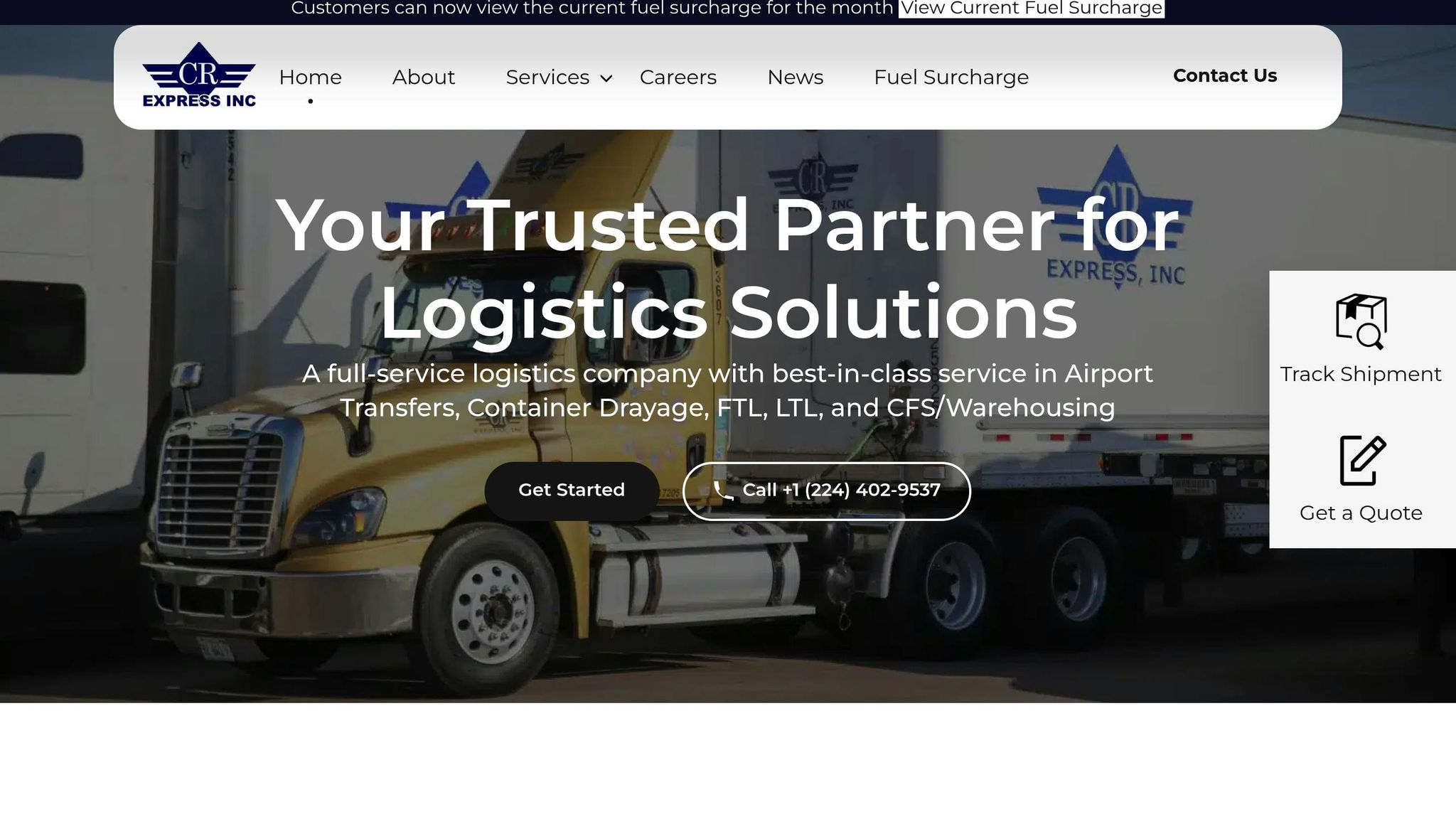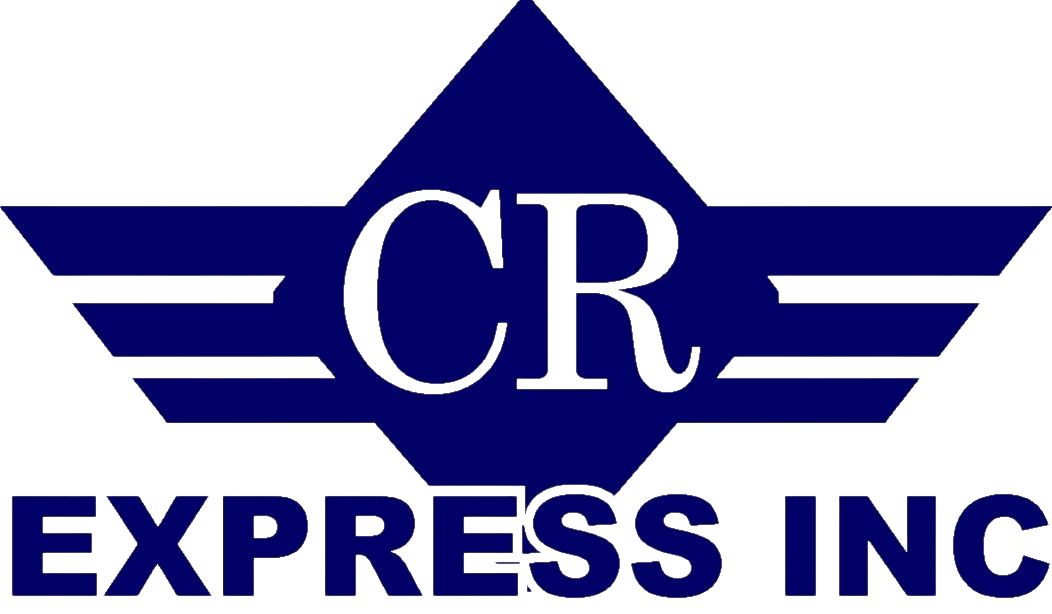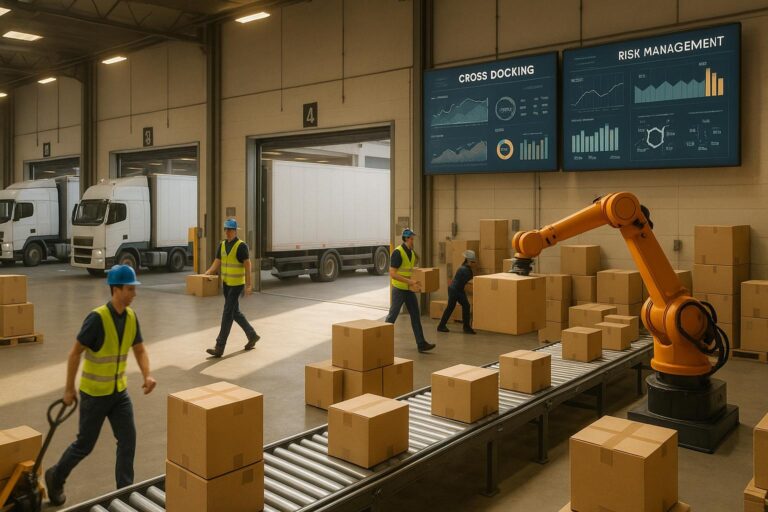Warehouse delays can disrupt supply chains, increase costs, and frustrate customers. The leading causes include poor inventory control, staffing shortages, inefficient layouts, outdated technology, shipping errors, external disruptions like weather, and regulatory challenges. Each issue has actionable solutions, such as adopting real-time tracking, cross-training staff, optimizing layouts, upgrading systems, automating shipping processes, planning for disruptions, and staying updated on compliance requirements.
Key Issues and Solutions:
- Inventory Problems: Use real-time tracking and automation to improve accuracy and efficiency.
- Staffing Gaps: Cross-train employees and use workforce management tools.
- Poor Layouts: Position high-demand items strategically and reduce congestion.
- Outdated Tech: Upgrade to modern warehouse management systems and cloud solutions.
- Shipping Errors: Automate address verification and label creation.
- External Factors: Plan for weather, traffic, and infrastructure issues with backup carriers and real-time tracking.
- Regulatory Delays: Automate compliance processes and partner with certified logistics providers.
By addressing these challenges proactively, businesses can reduce delays, improve efficiency, and enhance customer satisfaction.
Top Warehouse Problems and Practical Solutions | Boost Your Supply Chain Efficiency
1. Poor Inventory Control
Poor inventory control is often the root cause of warehouse delays. If you don’t know exactly what’s on your shelves, where it’s located, or how much you have, everything else can spiral out of control. Stockouts leave customers frustrated, while excess inventory eats up valuable space and ties up money. On top of that, order fulfillment errors can create a chain reaction of delays.
These issues are even more critical in industries where precision matters. For example, healthcare facilities can’t afford to run out of essential medical supplies. Automotive manufacturers relying on just-in-time production need accurate inventory counts to keep their assembly lines running smoothly. Electronics companies face added pressure with components that have short shelf lives, making accurate stock management even more crucial.
Unfortunately, many warehouses still depend on outdated manual processes or disconnected systems that fail to provide real-time data. Workers often waste time searching for items that are listed as available but are nowhere to be found. This leads to delayed customer orders and frantic efforts to locate missing stock or arrange last-minute shipments.
Real-Time Inventory Tracking
Real-time inventory tracking changes the game by offering instant visibility into stock levels, locations, and movements. Instead of relying on manual counts or periodic updates, these systems update inventory records immediately when items are moved in or out of the warehouse.
Technologies like barcode scanning and RFID are the backbone of these systems. Every time a worker moves or scans an item, the system updates automatically. This instant feedback eliminates the delays caused by outdated or inaccurate records.
But the benefits go beyond just knowing what’s in stock. Real-time tracking can highlight slow-moving inventory before it becomes a problem, uncover demand patterns to guide smarter purchasing decisions, and even help optimize your warehouse layout. For example, frequently picked items can be positioned in easily accessible locations to speed up operations.
When integrated with warehouse management systems, real-time tracking becomes even more powerful. These platforms can automatically trigger reorders, alert you to potential stockouts, and provide dashboards that give managers a clear picture of inventory health. By addressing issues before they escalate, these systems help prevent delays. Automation further enhances this process by reducing human error.
Automated Inventory Management Tools
Automation takes inventory management to the next level by removing human error and boosting efficiency. Automated systems handle routine tasks like cycle counting, reorder calculations, and tracking inventory movements without constant manual input.
For example, automated picking systems guide workers to the exact location of an item, verify the correct product, and update inventory records instantly. Advanced technologies like voice-directed picking or pick-to-light systems make the process even faster and more accurate.
Perpetual inventory systems powered by automation maintain continuous, real-time records of stock. This eliminates the need for disruptive physical counts, as every transaction is tracked as it happens. The result? More accurate data and reduced labor costs.
Automation also enables predictive capabilities. Machine learning can analyze historical data to forecast demand, pinpoint optimal reorder points, and flag unusual inventory patterns that might signal problems. These insights help avoid both stockouts and overstocking, reducing inefficiencies across the board.
Cycle Counting and Regular Audits
Cycle counting offers a practical way to keep inventory accurate without the hassle of shutting down for a full physical count. Instead of counting everything at once, inventory is divided into sections, and different parts are counted on a rotating schedule throughout the year.
The trick to effective cycle counting is prioritization. High-value items, fast-moving products, and items with a history of inaccuracies should be counted more frequently than slower-moving stock. This targeted approach saves time and improves accuracy where it matters most.
ABC analysis is a helpful tool for setting counting priorities. For instance:
- “A” items (high value or high volume) might be counted monthly.
- “B” items could be checked quarterly.
- “C” items might only need an annual count.
This method ensures that critical inventory gets the attention it needs while still keeping tabs on everything else.
Regular audits go beyond just counting items. They dig into the processes behind the numbers, identifying issues like locations prone to picking errors, frequently miscounted products, or flaws in receiving procedures. Fixing these root causes helps prevent future discrepancies rather than just correcting current ones, reducing delays in the long run.
Variance analysis from cycle counts can also provide valuable insights. If certain areas or products consistently show discrepancies, it’s a sign of deeper issues that need to be addressed. By tracking these patterns over time, warehouse managers can spot trends and make targeted improvements to streamline operations.
2. Staff Shortages and Poor Training
Staffing challenges can be a major roadblock to warehouse efficiency. When there aren’t enough workers to handle the workload, everything slows down. Add inadequate training into the mix, and you’ve got employees who are more likely to make errors, requiring extra oversight and reducing overall productivity.
These issues can hit industries in different ways. For example, healthcare distribution centers need to deliver essential supplies quickly, automotive parts warehouses rely on precision to support just-in-time manufacturing, and electronics facilities require workers with specialized skills to safely manage delicate components.
Cross-Training Employees
Cross-training can turn your team into a more adaptable workforce that’s ready to handle shifting demands. Instead of assigning workers to just one task, cross-training equips them to step into various roles as needed.
Take this scenario: If the receiving department is overwhelmed with incoming shipments, a cross-trained worker from another area can jump in to help. Or, if someone on the picking team is out, a trained packer can fill the gap, keeping operations on track.
To start, identify key areas like receiving, picking, packing, and shipping – these are often the bottlenecks when staffing is tight. Create step-by-step training materials for each role, and pair new trainees with experienced employees for hands-on learning.
Rotating employees between roles can further reinforce their skills while breaking up the monotony of their daily tasks. Documenting best practices in standard operating procedures gives your team a reliable resource to reference when needed. And with workforce management tools in place, scheduling and tracking cross-training efforts becomes even easier.
Workforce Management Tools
Workforce Management (WFM) solutions can take the guesswork out of staffing. These tools handle time tracking, labor organization, self-service options, and even safety management [1]. By integrating features like absence tracking and health and safety coordination with payroll systems, WFM tools streamline operations.
One of the biggest advantages is real-time visibility into staffing levels and productivity. Managers can use this data to adjust schedules based on demand. For instance, predictive scheduling analyzes past trends to ensure you have enough coverage during busy times. Performance tracking also helps pinpoint where additional training is needed, so you can address gaps before they become larger problems.
Self-service portals are another game-changer. They let employees manage tasks like requesting time off, swapping shifts, or checking their schedules online, which reduces administrative burdens and empowers workers. Plus, real-time alerts notify managers when staffing dips below optimal levels, allowing for quick adjustments.
Flexible Labor Solutions with CR Express

During peak periods, finding skilled temporary workers can be a challenge, especially for warehouses that need employees with logistics experience. That’s where CR Express steps in. Their staffing solutions provide access to trained logistics professionals who can hit the ground running with minimal onboarding.
CR Express offers a cost-effective way to scale your workforce during busy times without committing to full-time hires when demand slows down. Their staff is already familiar with standard warehouse protocols, ensuring smooth integration with existing teams.
For facilities with strict safety or regulatory requirements, CR Express can supply workers with the necessary certifications and training. They also maintain high standards through ongoing supervision and quality checks, so temporary staff can seamlessly support operations without compromising performance.
Whether it’s managing seasonal surges or meeting specialized needs, CR Express ensures your warehouse has the skilled workforce it needs to keep things running smoothly.
3. Poor Warehouse Layout and Processes
The way a warehouse is set up and operates plays a huge role in how efficiently it runs. A poorly thought-out layout can slow down order processing and fulfillment because workers waste time searching for items. This not only increases travel distances but also leads to worker fatigue and higher labor costs [2].
For industries where timing is everything – like healthcare, automotive, and electronics – these inefficiencies can cause serious delays. Bottlenecks in the warehouse can hold up shipments and disrupt overall productivity.
Smarter Layouts for Smoother Operations
Positioning fast-moving items closer to packing and shipping areas, guided by order data, can significantly speed up operations [2]. On the flip side, storing these high-demand products far from these zones adds unnecessary travel time, tires workers out, and increases the chances of product damage [2][3][4].
Aisle width is another key factor. If aisles are too wide, valuable storage space is wasted. If they’re too narrow, congestion becomes an issue, equipment movement is restricted, and the risk of accidents goes up [2][3][4].
4. System Failures and Outdated Technology
When warehouse systems crash or outdated technology struggles to keep up with demand, operations grind to a halt. Older systems often fail to meet the volume and integration requirements of today’s fast-paced supply chains. These technological shortcomings can lead to delays that ripple across the entire network, disrupting schedules and increasing costs.
Outdated warehouse management systems (WMS) often lack the ability to provide real-time visibility, forcing workers to rely on manual or paper-based processes. If barcode scanners fail or inventory databases go offline, downtime forces teams to switch to slower, less efficient methods. System downtime can cost thousands of dollars per hour, especially during peak seasons when every second counts. Upgrading these systems is no longer optional – it’s critical for maintaining operational efficiency.
Upgrading to Modern WMS Platforms
Modern warehouse management systems bring real-time tracking, automated workflows, and seamless integration with other business systems. Unlike older platforms that depend on manual data entry or batch updates, today’s solutions instantly update inventory levels as items move through the warehouse.
Advanced features like predictive analytics allow managers to anticipate potential bottlenecks and address them proactively. These systems can prioritize orders automatically based on factors like shipping deadlines, customer importance, or stock availability. Mobile-friendly interfaces further enhance efficiency by giving workers access to system functions directly from handheld devices, eliminating the need to return to fixed terminals.
When choosing a new WMS, integration capabilities are key. The system should work effortlessly with existing enterprise resource planning (ERP) software, transportation management systems, and e-commerce platforms. This connectivity reduces data silos and minimizes manual efforts to synchronize information across different systems.
Regular Maintenance and Data Backups
Preventive maintenance is essential for keeping warehouse technology running smoothly and avoiding major disruptions. Scheduling regular system updates, hardware inspections, and performance checks helps identify issues before they escalate. Many warehouses plan maintenance during off-peak hours to limit any operational impact.
Data backup strategies are equally important. Cloud-based backup solutions automatically sync data throughout the day, ensuring that recent transactions are preserved even if the primary system fails. Regularly testing recovery procedures ensures that backups can be restored quickly when needed, minimizing downtime.
Network infrastructure also needs ongoing attention to support growing data demands and device connections. Wireless networks that power handheld scanners and mobile devices must have sufficient bandwidth and reliable coverage throughout the warehouse. Redundant internet connections provide a safety net, keeping operations online if the primary service goes down.
Cloud-Based Solutions for Better Performance
Cloud-based warehouse management systems offer a reliable and high-performing alternative to traditional on-premises setups. Leading cloud providers operate multiple data centers with built-in redundancy, ensuring that warehouse operations continue even if one facility encounters an issue. Automatic scaling allows these systems to handle traffic spikes during busy periods without requiring manual adjustments.
By moving to the cloud, warehouses eliminate the need to maintain their own servers and IT infrastructure. Software updates occur automatically, keeping systems up-to-date with the latest features and security patches. This reduces the burden on warehouse managers, allowing them to focus on daily operations instead of technology upkeep.
Another major advantage of cloud-based systems is their flexibility in integration. They can easily connect with transportation partners, suppliers, and customers through standardized APIs and data formats. This enables features like automated shipping notifications, real-time tracking updates, and seamless data exchanges with trading partners.
Cloud solutions also offer predictable costs, with monthly subscription fees replacing the large upfront investments required for on-premises hardware. This model allows warehouses to adjust their technology spending based on seasonal demand or business growth. Beyond reducing downtime, cloud-based systems align perfectly with broader logistics improvements, making them an ideal choice for warehouses looking to stay competitive in an ever-evolving market./banner/inline/?id=sbb-itb-c0b8770
5. Shipping and Documentation Errors
Shipping and documentation mistakes can lead to expensive delays, frustrated customers, and unnecessary costs. Errors like incorrect addresses or incomplete paperwork often result in return shipments, extra postage fees, and lost trust. These issues frequently stem from manual data entry under pressure, leading to typos, wrong weights, or missing customs forms. Address errors, in particular, are costly – businesses lose an average of $5 per shipment on undeliverable packages [5]. Beyond the financial hit, these mistakes force warehouse teams to spend valuable time fixing problems, handling returns, and arranging reshipments. For international shipments, documentation errors can cause even greater disruption, with missing or incorrect customs forms leading to extended delays. To avoid these headaches, companies need to invest in automation and implement tighter quality controls.
Industries like healthcare, automotive, and electronics are especially vulnerable, where even small mistakes can delay critical deliveries and disrupt operations.
Address Verification Tools
Automated address verification tools are essential for catching errors before packages leave the warehouse. These systems check shipping addresses against official postal databases to ensure accuracy. For instance, EasyPost‘s Address Verification validates addresses in real time during order processing, helping businesses avoid unnecessary costs tied to incorrect shipments [5]. When integrated with warehouse management systems, these tools operate seamlessly, flagging issues for staff only when manual intervention is required. They also standardize address formats, which simplifies delivery and reduces confusion.
Automated Label Generation
Automated label generation systems minimize manual input errors while speeding up the shipping process. Solutions like InfoShip software create shipping labels automatically, using pre-set rules for package dimensions and weight to ensure precision [6]. By pulling data directly from verified order information, these systems ensure every label is accurate and ready to go.
Training Staff on Documentation Standards
While technology plays a critical role in reducing errors, well-trained staff are just as important for handling the complexities of shipping documentation. Proper training ensures employees understand the importance of accuracy and know how to manage different shipping requirements. Standardized procedures help maintain consistency, especially during peak periods.
“Documentation processes in the logistics industry often proceed manually by entering data into the system… This process can be made easier by digitizing the documents.” – ILDIZHAN TÜRER, Route Sales Manager | Sales Hunter | Logistics Speaker [7]
Training programs should focus on common documentation mistakes and their consequences, offering hands-on practice to build confidence. Cross-training team members to handle complex documentation can prevent delays when specialized staff are unavailable. Regular refresher courses and audits can also pinpoint recurring issues, reinforcing the importance of accuracy and showing employees how their work impacts the broader supply chain.
6. Weather, Traffic, and Infrastructure Problems
External factors like severe weather, traffic jams, and outdated infrastructure can wreak havoc on operations and delivery schedules. Events such as hurricanes, snowstorms, flooding, and extreme heat can bring operations to a halt for days. On top of that, aging infrastructure – think bridge closures, road construction, and overcrowded ports – adds to the logistical headaches.
These issues hit hardest in industries where timing is everything. For example, healthcare facilities rely on timely deliveries of medical supplies and medications. Automotive manufacturers, operating on tight just-in-time schedules, have little room for delays. Electronics companies feel the same heat, particularly during peak seasons when consumer demand surges. Such disruptions don’t just affect delivery timelines – they can also drive up costs and impact customer satisfaction over the long haul.
Winter storms can shut down highways for hours or even days, while summer heat waves can challenge refrigerated transport systems. Hurricanes along the Gulf Coast and Eastern Seaboard often disrupt port operations, sending shockwaves through supply chains. Even short-lived events, like sudden thunderstorms, can create cascading delays. These realities highlight the importance of having strong contingency strategies in place.
Creating Backup Plans
Planning for disruptions begins with understanding the specific risks tied to your location and routes. For instance, warehouses in tornado-prone areas require different preparations than those in regions prone to hurricanes or snowstorms. Weather monitoring systems that issue automatic alerts can give teams critical lead time to activate backup procedures before problems escalate.
One effective approach is securing multiple carriers and transportation providers to ensure alternatives are available when primary routes are blocked. Companies with diverse carrier networks often maintain better service levels during disruptions. Cross-docking facilities in various regions also add flexibility, enabling shipments to bypass problem areas.
Seasonal patterns and historical data play a big role in alternative routing strategies. For example, businesses operating in snow-heavy regions might pre-position inventory in southern distribution centers during winter. Similarly, companies in hurricane-prone areas often stock up on inventory ahead of storm seasons, ensuring smoother operations even when transportation networks face challenges.
Real-Time Route Planning and Tracking
Once backup plans are in place, modern technology can take disruption management to the next level. GPS-enabled tracking systems provide real-time visibility into shipment locations, helping dispatchers quickly identify and address issues. If traffic accidents or weather events block primary routes, these systems can automatically calculate alternative paths, saving valuable time.
Dynamic routing platforms integrate data from multiple sources – traffic updates, weather forecasts, construction schedules, and historical delivery trends – to continuously refine routes. This is particularly crucial during busy shipping seasons, where even minor delays can snowball into major disruptions. Advanced systems can even predict potential bottlenecks hours ahead, allowing for proactive adjustments.
Real-time communication tools are equally vital. Mobile apps let drivers report unexpected delays or road conditions instantly, while automated notifications keep customers updated and reduce the need for service calls. This level of transparency helps maintain trust and strong customer relationships, even when delays are unavoidable.
Disruption Management with CR Express
CR Express has extensive experience managing disruptions across various transportation modes and regions. Their expansive facilities allow for flexible shipment consolidation, storage, or rerouting when disruptions strike.
Their service portfolio includes airport transfers, container drayage, full truckload (FTL) and less-than-truckload (LTL) shipping, and cross-docking capabilities, all designed to adapt quickly when primary transportation methods are impacted. With TSA-approved transportation services, CR Express ensures security remains a priority, even during emergency rerouting.
For international shipments, their bonded warehousing capabilities are a game-changer, especially when dealing with port delays or customs bottlenecks. Temperature-controlled storage options safeguard sensitive goods during extended delays, while specialized handling for hazardous or high-value materials ensures safety and compliance throughout the process.
7. Compliance and Regulatory Problems
Regulatory compliance is a major factor in avoiding costly delays in warehouse operations. When shipments fail to meet federal, state, or international requirements, they can be held at checkpoints, sent back to the sender, or even seized by authorities. This is particularly challenging for regulated industries like pharmaceuticals, food and beverage, chemicals, and electronics, where strict safety and documentation standards are non-negotiable. Addressing these challenges is key to keeping operations running smoothly.
Modern supply chains make compliance even trickier. A single shipment might need to meet FDA food safety rules, DOThazardous materials requirements, TSA air transport standards, and customs documentation for international deliveries. For instance, healthcare companies shipping medical devices must ensure detailed tracking and maintain temperature records, while electronics manufacturers dealing with lithium batteries must navigate varying shipping restrictions depending on the mode of transport.
International shipments face even more obstacles. Country-specific import rules and changing trade compliance requirements can derail shipments. Something as simple as a missing certificate of origin or an incorrect tariff classification can lead to customs holds, causing delays and additional costs.
Staying Current on Regulations
Keeping up with ever-changing regulations is no small task. Agencies like the Department of Transportation frequently update hazardous materials rules, while the FDA regularly revises food safety standards and medical device requirements. Relying on manual tracking often leads to missed updates and compliance mishaps.
To stay informed, teams can subscribe to regulatory alerts from sources like the Federal Register or trade associations. Many companies also appoint compliance officers to track changes and share updates with relevant teams. Regular training sessions that cover current regulations, documentation procedures, and handling requirements for specialized goods can help reduce human errors that cause delays. Monthly compliance reviews are another useful tool for discussing recent changes and learning from past mistakes. Automating compliance processes can make this effort even more efficient.
Compliance Management Software
Compliance management software can take much of the burden off teams by automating key regulatory tasks. These platforms integrate with warehouse management systems to flag shipments requiring special handling, generate necessary documents, and track compliance deadlines. Just as warehouse management systems reduce downtime, these tools help avoid regulatory bottlenecks.
For example, automated systems can produce shipping documents, minimizing manual entry errors. They also assist with generating shipping papers for hazardous materials and ensure packaging meets regulatory standards. Real-time monitoring features can flag expired certifications or missing documentation before shipments reach checkpoints, allowing teams to address issues proactively. Additionally, audit trails created by these platforms provide proof of consistent compliance during inspections.
Certified Logistics Providers like CR Express
Expert logistics partners can further simplify compliance. Certified providers like CR Express bring specialized expertise and established procedures to tackle regulatory challenges. For example, CR Express offers TSA-approved transportation services to meet air cargo security requirements and certified container freight station (CFS) capabilities for navigating complex customs processes.
Their bonded warehousing facilities offer secure storage for international goods awaiting customs clearance, preventing delays caused by documentation issues. This is especially valuable for high-value electronics or time-sensitive medical supplies, which can’t afford extended customs holds. Bonded storage allows goods to remain secure while compliance issues are resolved, avoiding the need to return shipments to the sender.
CR Express also provides certified handling for hazardous materials and high-value goods to meet DOT and other regulatory standards. Their temperature-controlled storage ensures that products stay within required temperature ranges during storage and transport. By combining technology, expertise, and specialized facilities, CR Express helps minimize regulatory delays, keeping supply chains on track and maintaining customer trust.
Conclusion: Fixing Warehouse Delays for Better Results
Warehouse delays don’t have to be a constant headache. The seven common causes we’ve discussed – like poor inventory management, staffing shortages, compliance issues, and system failures – all come with practical solutions that can streamline operations.
Start by pinpointing the root causes of delays in your warehouse. From there, implement specific fixes, such as upgrading to real-time inventory tracking systems, reconfiguring the layout for smoother workflows, or adopting automated picking and packing tools. Each step creates a ripple effect, improving efficiency across the board. Modern tools and established best practices can make these changes even more impactful.
Technology plays a big role, but don’t overlook the basics. Regular equipment maintenance, thorough staff training, and solid backup plans are just as important. Cloud-based systems can add reliability and scalability, while automation helps cut down on human errors that often lead to shipping or documentation delays.
External challenges like bad weather, traffic, or regulatory changes can throw a wrench in the works, but having contingency plans and using real-time tracking with dynamic routing can help keep things on track.
Combining these strategies with a partner like CR Express can take your logistics to the next level. Their extensive facilities, certified expertise, and customized services offer a comprehensive approach to overcoming warehouse delays.
Addressing these issues doesn’t just save time – it improves customer satisfaction, reduces costs, and strengthens your supply chain. Businesses that tackle these seven common causes head-on often see fewer urgent shipments, lower overtime expenses, and better relationships with their customers and suppliers.
FAQs
How does real-time inventory tracking help reduce warehouse delays and improve efficiency?
Real-time inventory tracking significantly boosts warehouse efficiency by giving instant insights into stock levels. This helps prevent common problems like running out of stock or overstocking, ensuring operations stay on track without unnecessary delays.
By automating tasks like reordering and improving accuracy, real-time tracking cuts down on manual mistakes and speeds up decision-making. It also enables warehouses to respond quickly to changes, reducing downtime and keeping the supply chain running smoothly. The result? Smoother workflows, lower costs, and improved productivity across the board.
How does cross-training employees in a warehouse help manage staffing shortages?
Cross-training employees in a warehouse setting allows for more flexibility and helps tackle staffing gaps by equipping workers to handle different roles when necessary. This keeps operations running efficiently during busy times or when certain positions are understaffed.
On top of that, cross-training promotes collaboration and boosts employee involvement, as team members develop a clearer understanding of diverse tasks and workflows. It also strengthens the workforce’s adaptability, minimizing disruptions and ensuring productivity stays on track, even when unexpected challenges arise.
What steps can warehouses take to prepare for disruptions like severe weather or infrastructure issues?
Warehouses can better handle disruptions like severe weather or infrastructure problems by developing a thorough emergency preparedness plan. This plan should cover risk assessments, detailed response procedures, and regular staff training to ensure everyone is ready to act when needed.
Upgrading infrastructure can also play a big role in reducing potential damage. Think of storm-resistant buildings or temperature-controlled systems that protect both the facility and its inventory. On top of that, having backup power supplies, clear communication strategies, and strong ties with local suppliers and networks can make a huge difference in bouncing back quickly after an event. Lastly, don’t overlook your insurance coverage – making sure it aligns with potential risks can provide a safety net when the unexpected happens.





